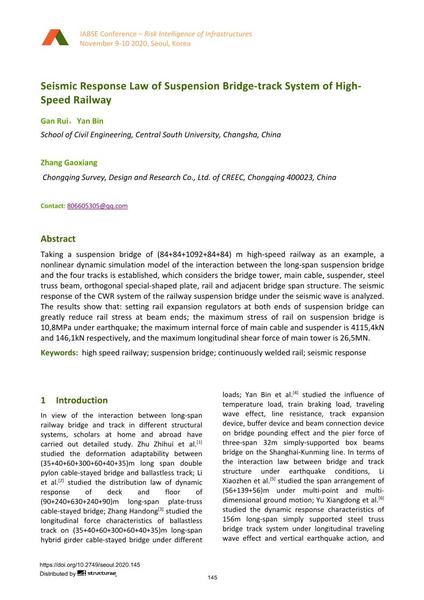Seismic Response Law of Suspension Bridge-track System of High- Speed Railway

|
|
|||||||||||
Bibliografische Angaben
| Autor(en): |
Gan Rui
(School of Civil Engineering, Central South University, Changsha, China)
Yan Bin (School of Civil Engineering, Central South University, Changsha, China) Zhang Gaoxiang (Chongqing Survey, Design and Research Co., Ltd. of CREEC, Chongqing 400023, China) |
||||
|---|---|---|---|---|---|
| Medium: | Tagungsbeitrag | ||||
| Sprache(n): | Englisch | ||||
| Tagung: | IABSE Conference: Risk Intelligence of Infrastructures, Seoul, South Korea, 9-10 November 2020 | ||||
| Veröffentlicht in: | IABSE Conference Seoul 2020 | ||||
|
|||||
| Seite(n): | 145-150 | ||||
| Anzahl der Seiten (im PDF): | 6 | ||||
| DOI: | 10.2749/seoul.2020.145 | ||||
| Abstrakt: |
Taking a suspension bridge of (84+84+1092+84+84) m high-speed railway as an example, a nonlinear dynamic simulation model of the interaction between the long-span suspension bridge and the four tracks is established, which considers the bridge tower, main cable, suspender, steel truss beam, orthogonal special-shaped plate, rail and adjacent bridge span structure. The seismic response of the CWR system of the railway suspension bridge under the seismic wave is analyzed. The results show that: setting rail expansion regulators at both ends of suspension bridge can greatly reduce rail stress at beam ends; the maximum stress of rail on suspension bridge is 10,8MPa under earthquake; the maximum internal force of main cable and suspender is 4115,4kN and 146,1kN respectively, and the maximum longitudinal shear force of main tower is 26,5MN. |
||||
| Stichwörter: |
Hängebrücke
|
||||


